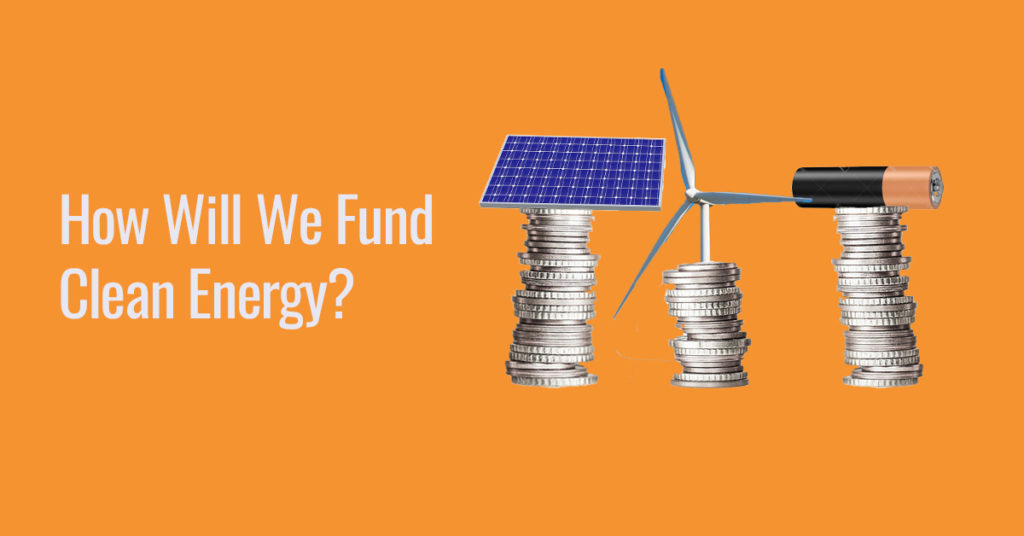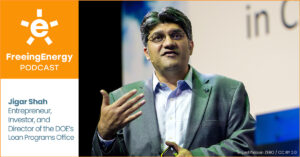This is the second in our series on financing the clean energy disruption/revolution. The first part explores the cleantech bubble of 2011.

Even conservative estimates forecast that transitioning to clean energy will require trillions of dollars of investments. Where will all this money come from? For better or worse, nearly all of it will come from traditional financial sources like governments and banks. These are highly risk-averse institutions. They do not change easily and few are ready to invest at the scale required. To help push them along, thousands of groups, from corporations to political leaders, from to economists to activists, are advocating for legislative and policy changes. While this is an incredibly important process, the sheer scope of the industry and countless entrenched interests means substantial change will take decades or even generations.
Fortunately, not all investors are so risk-averse. There is another source of funding that is far more willing to embrace risky bets – venture capital. This is the same source of money that helped create Google, Apple, and Uber. Compared to global banks and governments, VC funds are tiny. Nonetheless, similar to computing, medical devices, the internet, and other industries, venture capital is a great fit for many types of clean energy companies.
To understand how VC works and the unique role it plays, let’s look at the three drivers of successful VC investing.
GET MONTHLY NEWS & ANALYSIS
Unsubscribe anytime. We will never sell your email or spam you.
What are the three characteristics that most VCs look for in investments?
In the mid 1990’s, I had the privilege of working at a well respected venture capital firm called Greylock. It was an amazing time. My partners and I had front row seats to one of the most remarkable eras in business history: the internet’s transformation from an academic network into a commercial juggernaut. Just before I started at Greylock, there were a little over 100,000 domain names in the world. When I left to run one of the internet companies we’d funded, there were already 2,000,000. Today, about 20 years later, there are well over 300,000,000 domain names.
Venture capital is a unique form of investing. It is one of the few that assumes many of its investments will go belly up. The key to successful VC is having a small handful of investments that are wildly successful – more than enough to make up for the losses. This is how VC manages to regularly outperform most other investment classes.
#1 – High margins
VCs love businesses like software and media because it costs almost nothing to sell a product to a customer. Nearly all the revenue becomes cash flow. This cash can be used to fund R&D to accelerate product development. It can be used to fund sales and marketing to add rocket fuel to an already fast-growing business. By comparison, hardware or any kind of physical asset ties up cash and can’t be repurposed if a better idea comes along. Flexibility is a strategic advantage. I like to say that “bits are better than atoms” which is a way of saying that software is a lower risk investment than hardware and infrastructure.
#2 – Big exits
To make up for the handful of investments that go belly up, VCs need a few of their companies to generate huge returns. There is even a term, “ten-bangers”, for companies that return ten times (or more) their initial investment. High priced acquisitions and big IPOs are the most lucrative types of exits. Google is one of the most spectacular examples of all time. In 1999, VC firms Kleiner Perkins and Sequoia each invested $12.5 million in a second round funding. After Google’s IPO, each of their shares was worth about $4.3 billion, creating an astonishing “300-banger” for each firm.
#3 – Fast growth
If there is one key ingredient to successful VC investing, it’s finding fast growth companies. It’s difficult to overstate the importance of this. Companies that grow fast enough make it very hard for competitors to ever catch up. It gives early innovators a better chance at grabbing a dominant market share. Fast growth is the largest driver of valuations in acquisitions and IPOs. Best of all, if a company can grow fast enough and big enough, it becomes a disruptor – it goes beyond its own success and redefines the rules of entire industries. It grabs revenue away from entrenched incumbents.
Venture capital is a catalyst, not a replacement for the more traditional cleantech funding
In my previous article, How venture investors lost $10 billion in the cleantech collapse of 2011, I explored the dramatic implosion of the Cleantech 1.0 funding bubble. VCs lost their shirts and cleantech has been a four-letter word since. Fortunately, investors learned a lot and there are many reasons to be optimistic about Cleantech 2.0. Among them is the hard-learned lesson that venture capital isn’t a fit for every type of cleantech investing. In my next article, I will breakdown the types of cleantech investments and explain where VC best fits. In the meantime, it’s sufficient to understand that venture capital is a catalyst for other, more risk-averse types of cleantech investing. By focusing largely on new technologies and new business models, VCs change the investment returns for the rest of the industry.
Let me explain. Venture capital firms won’t fund giant wind farms or huge solar manufacturing plants any more than they funded, for example, the data centers and fiber optic networks that power the internet. But, VCs did fund the companies that created the fiber optic switches. The resulting switches leapfrogged previous technologies in cost and functionality. This meant that data centers and fiber optic networks could be more profitable which, in turn, made them more attractive to traditional investors like banks. For cleantech, new technologies and new business models from VC-backed companies will lower the risk, improve the profits, and increase the returns for traditional sources of capital like banks and governments.
Venture capital is an essential component of a clean energy future. Without the catalyst of VC funds and the companies they enable, the power industry’s sluggish innovation has little chance of speeding up – the transition to clean energy will take decades longer than necessary. Aggressive venture investments in the Cleantech 2.0 era are crucial catalyst to enable the much larger and more risk-averse set of investors to become comfortable funding the clean energy future.
In my next article, I will review the five categories of cleantech investing and explain which are best suited for venture capital funds. My goal is to help the next generation of cleantech investors make the best possible bets and, in turn, drive the entire cleantech ecosystem forward as quickly as possible.




4 Responses
A 2KW fuel cell will cost $800 and solve a household’s intermittency of solar and wind indefinitely. $800 spent on batteries, will solve a one day problem at most. The capital cost for worldwide, batteries only, is unthinkable. The worldwide cost of natural gas service, and a fuel cell per household, is tiny by comparison. By grading natural gas energy as unclean, you are letting the perfect be the enemy of the good. Fuel cells using methane and producing pure CO2 are here experimentally. The pure CO2 can be sequestered, or repurposed.
Addendum to my last post.
When I wrote the above, I thought that I was looking at about a decade out. A little wandering about on the web, reveals that a German company is offering a, small refrigerator sized, methane fuel cell, for the stated purpose of decreasing your electric bill. I am sure that the cost is several times my projected $800, but I think that Freeing Energy should consider the comparison of this approach, with the very large batteries, that could run a household for a week. The fuel cell could, of course, run the household indefinitely. Also, this is an example of venture capital funding today.
Newt, I agree that natural gas / methane can and will play a big role in the next generation residential and community-scale energy systems. Small-scale fuel cells can achieve the 50%+ efficiency of large-scale natural gas turbines – but they are very expensive. Natural gas combustion engines or generators are not nearly as efficient but they are much less expensive.
It all comes down to costs. If fuel cells are the least expensive way to generate electricity, they’ll be widely adopted. But, if solar is the least expensive, as most people predict, then batteries, fuel cells, and generators will play a symbiotic role with solar – solar will be used whenever it is available and these other sources will kick in when solar isn’t available. The balance between batteries, fuel cells and generators will ultimately come down to relative costs and local regulations.
What does your research show? Are there fuel cell technologies out there that have the potential to beat solar on a kwh basis in the next 10-20 years? If you have some articles that point to 3-4 cent per kwh (including fuel) for future generation fuel cells, I’d love to read more about it.
I don’t expect fuel cells to displace solar. I do expect them to greatly decrease the size of batteries, in solar powered systems. Complete removal of long duration shade intermittency, is a problem that batteries can never economically solve. Fuel cells can decrease the cost of a KWH below that of grid delivered electricity. It is the grid, not solar that is endangered. This can enable a large part of the Freeing Energy goal of more localized generation, and less monopoly control of green energy progress.
Self serving addendum: The DC Transformer, invented in 2016, will eventually improve the economics of grid delivered electricity, by eliminating skin effect losses, and power factor losses and corrections. Long before that, the DC Transformer will improve DC microgrids worldwide.